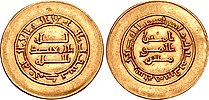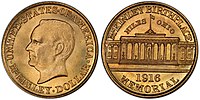Wikipedia:WikiProject Numismatics/newsletter/November 2019
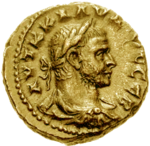
|
The WikiProject Numismatics newsletter |
|---|---|
| Issue VIII | |
Article of the Month
[edit]The euro (sign: €; code: EUR) is the official currency of 19 of the 28 member states of the European Union. This group of states is known as the eurozone or euro area, and counts about 343 million citizens as of 2019. The euro, which is divided into 100 cents, is the second-largest and second-most traded currency in the foreign exchange market after the United States dollar.
The currency is also used officially by the institutions of the European Union, by four European microstates that are not EU members, as well as unilaterally by Montenegro and Kosovo. Outside Europe, a number of special territories of EU members also use the euro as their currency. Additionally, over 200 million people worldwide use currencies pegged to the euro.
The euro is the second-largest reserve currency as well as the second-most traded currency in the world after the United States dollar. As of August 2018, with more than €1.2 trillion in circulation, the euro has one of the highest combined values of banknotes and coins in circulation in the world, having surpassed the U.S. dollar.
The name euro was officially adopted on 16 December 1995 in Madrid. The euro was introduced to world financial markets as an accounting currency on 1 January 1999, replacing the former European Currency Unit (ECU) at a ratio of 1:1 (US$1.1743). Physical euro coins and banknotes entered into circulation on 1 January 2002, making it the day-to-day operating currency of its original members, and by March 2002 it had completely replaced the former currencies. While the euro dropped subsequently to US$0.83 within two years (26 October 2000), it has traded above the U.S. dollar since the end of 2002, peaking at US$1.60 on 18 July 2008. In late 2009, the euro became immersed in the European sovereign-debt crisis, which led to the creation of the European Financial Stability Facility as well as other reforms aimed at stabilising and strengthening the currency. (Full article...)
News
[edit]Project
[edit]- The 2019 US Banknote Contest has started, users wishing to participate may join in here.
Content
[edit]Featured Articles
Other
[edit]- San Francisco–Oakland Bay Bridge half dollar (discussion) is under review for Featured Article status.
- Colored coin has been proposed for deletion.
On the Main Page
[edit]Today's Featured Article
[edit]| October 15 |
|
Al-Mu'tadid (c. 857 – 5 April 902) was the Abbasid Caliph from 15 October 892 until his death. As a prince, he served under his father al-Muwaffaq during various military campaigns and helped suppress the Zanj Rebellion. As caliph, he restored to the Abbasid state some of the power it had lost during the turmoils of the previous decades. In a series of campaigns he recovered the provinces of Jazira, Thughur and Jibal, and effected a rapprochement with the Saffarids in the east and the Tulunids in the west. He brought the capital back to Baghdad, where he engaged in major building projects. He was a firm supporter of Sunni traditionalist orthodoxy, and notorious for his fiscal stringency and cruel punishments, but also interested in the learning and science that had flourished under his predecessors, promoting men like Thabit ibn Qurra, a mathematician and translator of Greek texts. His reign marks the last revival of the Abbasid empire before its terminal decline during the 10th century. (Full article...) |
| October 16 |
|
The McKinley Birthplace Memorial gold dollar was a commemorative coin struck by the United States Bureau of the Mint in 1916 and 1917, with the obverse designed by Mint Chief Engraver Charles E. Barber, and the reverse by his assistant, George T. Morgan. As William McKinley had appeared on a version of the 1903-dated Louisiana Purchase Exposition gold dollar, the 1916 release made him the first person to appear on two issues of U.S. coins. The coins benefitted the National McKinley Birthplace Memorial at Niles, Ohio. The issue was originally proposed as a silver dollar; this changed when it was realized it would not be appropriate to honor a president who had supported the gold standard with such a piece. The coins were poorly promoted, and did not sell well. Despite an authorized mintage of 100,000, only about 20,000 were sold, many of these at a reduced price to Texas coin dealer B. Max Mehl. Another 10,000 pieces were returned to the Mint for melting. (Full article...) |
Picture of the Day
[edit]October 10
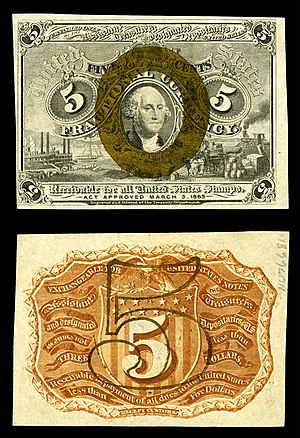 |
Fractional currency, also referred to as shinplasters, was introduced by the United States federal government following the outbreak of the Civil War. These low-denomination banknotes of the U.S. dollar were in use between 21 August 1862 and 15 February 1876; they were issued in denominations of 3, 5, 10, 15, 25 and 50 cents across five issuing periods. The notes could be redeemed by the U.S. Postal Service for the face value in postage stamps.
This picture shows a second-issue twenty-five-cent (25¢) fractional currency note, issued by the United States Department of the Treasury between 1863 and 1867, featuring a portrait of George Washington, the first president of the United States, on the obverse. This note is in the National Numismatic Collection of the Smithsonian Institution's National Museum of American History. |
October 13
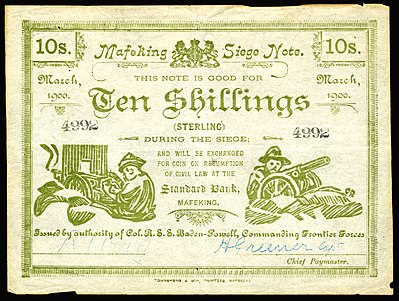 |
Siege of Mafeking currency was issued by the British commander, Colonel Robert Baden-Powell, during the 217-day siege for the town of Mafeking (now Mahikeng) in South Africa from 13 October 1899 to 17 May 1900, during the Second Boer War. To ease the problems caused by the lack of genuine banknotes, Baden-Powell authorised the issue of siege banknotes in late 1899. Made by Mafeking printers Townshend & Son using woodcut printing, notes were backed by the Standard Bank of South Africa and issued in denominations of one-, two-, three- and ten-shilling coupons, as well as one-pound notes, of which 620 were printed. The intention was that, after the siege was over, these could be exchanged for genuine currency, but in practice few were; most were kept as souvenirs.
This picture shows a ten-shilling note from the Siege of Mafeking, dated March 1900; it is now in the National Numismatic Collection of the Smithsonian Institution's National Museum of American History. |
New members are added to the subscriber list • If you are not a member and would like to receive this newsletter, or are a member but would not like to receive future issues, you may subscribe/unsubscribe here
Delivered by ZLEA via ~ at ~~~


